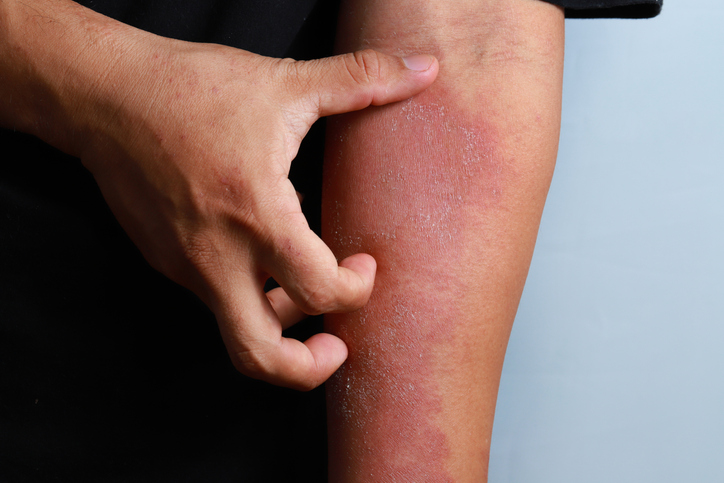Pain
10 of the Rarest Skin Conditions
Source: Healthline, WebMD, Genetic and Rare Diseases Information Center: National Center for Advancing Translational Sciences: National Institutes of Health, MedlinePlus, Genetic and Rare Diseases Information Center: National Center for Advancing Translational Sciences: National Institutes of Health

4 people found this helpful
Print
Share
Save
The skin is the body’s largest organ; it consists of three layers: the epidermis (the top layer of skin, which provides a waterproof barrier), the dermis (the middle layer, which is made up of connective tissue, nerves, sweat glands, and hair follicles), and the hypodermis (the bottom layer, which consists of connective tissue and fat). The skin is a complex organ and, therefore, can be affected by a variety of medical conditions.
Skin conditions range from extremely rare to very common. Ten of rarest skin conditions include the following:
- Blau syndrome is a genetic inflammatory condition that typically develops before the age of 4. Granulomatous dermatitis — a scaly rash on the trunk or extremities and hard nodules under the skin — is typically the first symptom of Blau syndrome. Arthritis and uveitis (inflammation in the middle layer of the eye) are also characteristic of the condition. Although Blau syndrome is inherited, in some cases, individuals have symptoms of the condition but do not have a family history; in these cases, they may be diagnosed with a non-inherited type of Blau syndrome called early-onset sarcoidosis.
- Dowling-Degos disease is a genetic skin condition that involves lacy patterns of darkened skin, especially in the folds and creases of the body, such as the armpits, groin, and the skin over joints. It can also cause pus-filled lumps on the neck, armpits and back. Dowling-Degos disease typically develops in late childhood or early adolescence but can also occur in adulthood.
- Elastoderma is a very rare condition that is characterized by extremely stretchy, loose, flexible skin. It may sag or fold, especially on the neck, elbows or knees. The cause of elastoderma is not clear; however, it may be caused by overproduction of elastin (a protein in connective tissue that provides structural support).
- Epidermolytic ichthyosis is a genetic skin disease that is apparent at or shortly after birth. Symptoms include red, blistered, inflamed, and extremely sensitive skin. Rows of thick, hardened scales, usually located in creases of the joints, develop on the skin. Treatment involves the removal of the scales, which creates fragile, sensitive skin that is more prone to infection.
- Harlequin ichthyosis is a skin condition caused by a genetic mutation. The symptoms of hard, thick, scale-like plates of skin are apparent at birth. The plates can distort facial features and restrict movement. Harlequin ichthyosis can affect the body’s ability to regulate body temperature, manage water loss, and fight infection.
- Morgellons disease is a rare skin condition that presents as lesions in one distinct area: the head, trunk, or extremities. The main symptom of Morgellons disease is the sensation that something is crawling on the skin. Other symptoms include rashes, sores, or fibers in or on the skin. It is commonly associated with Lyme disease.
- Peeling skin syndrome is a hereditary skin condition that causes the top layer of skin to peel and tear easily. Although it isn’t painful, it is often itchy. The skin can become dry, red, and thick. It typically presents during childhood but can also appear in adulthood.
- Pemphigus vulgaris is an autoimmune disease characterized by painful blistering and erosion of the skin or mucous membranes. With this condition, the immune system mistakenly attacks healthy cells in the epidermis. In many cases, blisters first form in the mouth, followed by the development of blisters on other areas of the body.
- Primary cutaneous amyloidosis is categorized into three types: lichen amyloidosis, macular amyloidosis, and nodular amyloidosis. It is characterized by the build up of a specific protein (amyloid) in the skin. Symptoms and affected areas of the body differ depending on the type of primary cutaneous amyloidosis. Symptoms include itchy, raised, reddish-brown spots; dusty-looking or grayish patches of skin; or firm, non-itchy, reddish bumps.
- Xeroderma pigmentosum is a genetic condition that causes the skin and eyes to be extremely sensitive to ultraviolet rays (including lightbulbs). Symptoms include severe sunburn; patches of light or dark skin; and dry skin and eyes. Individuals with xeroderma pigmentosum are 10,000 times more likely to develop skin cancer.










